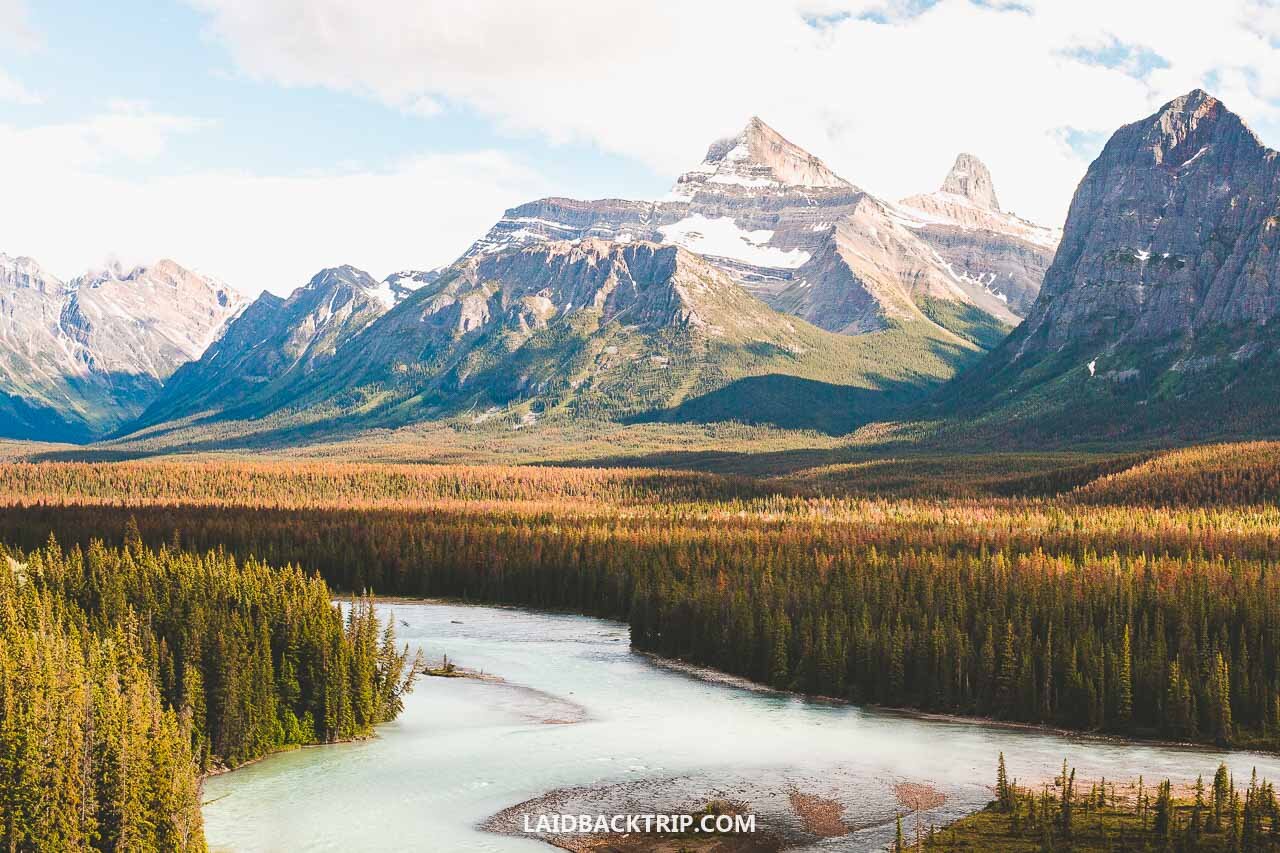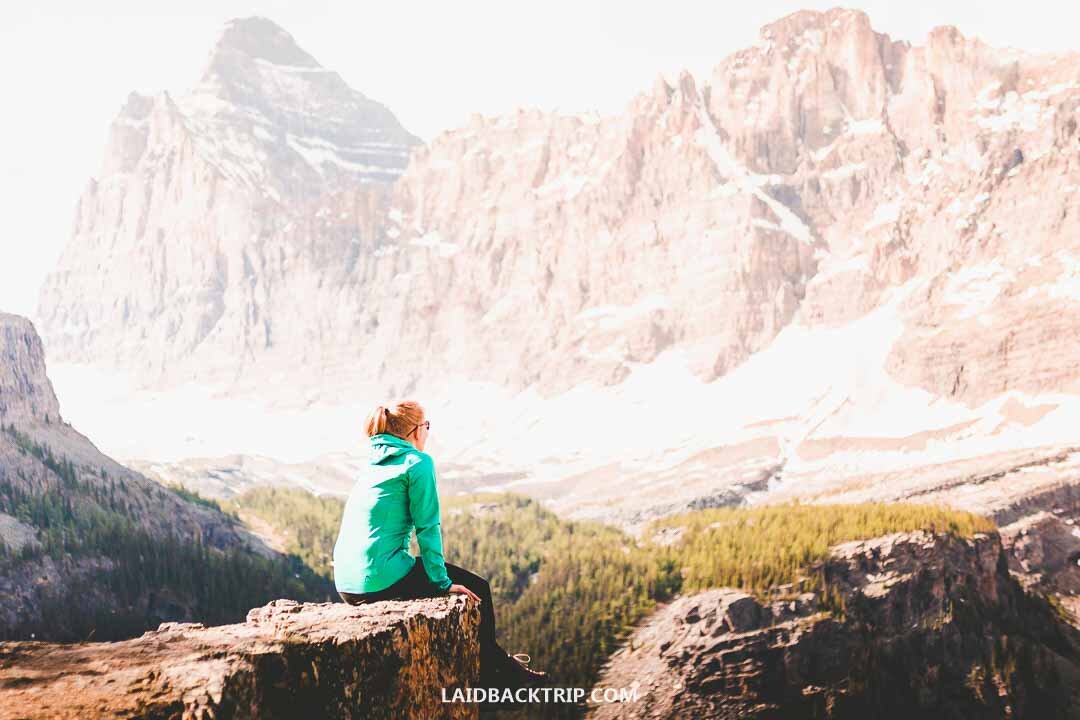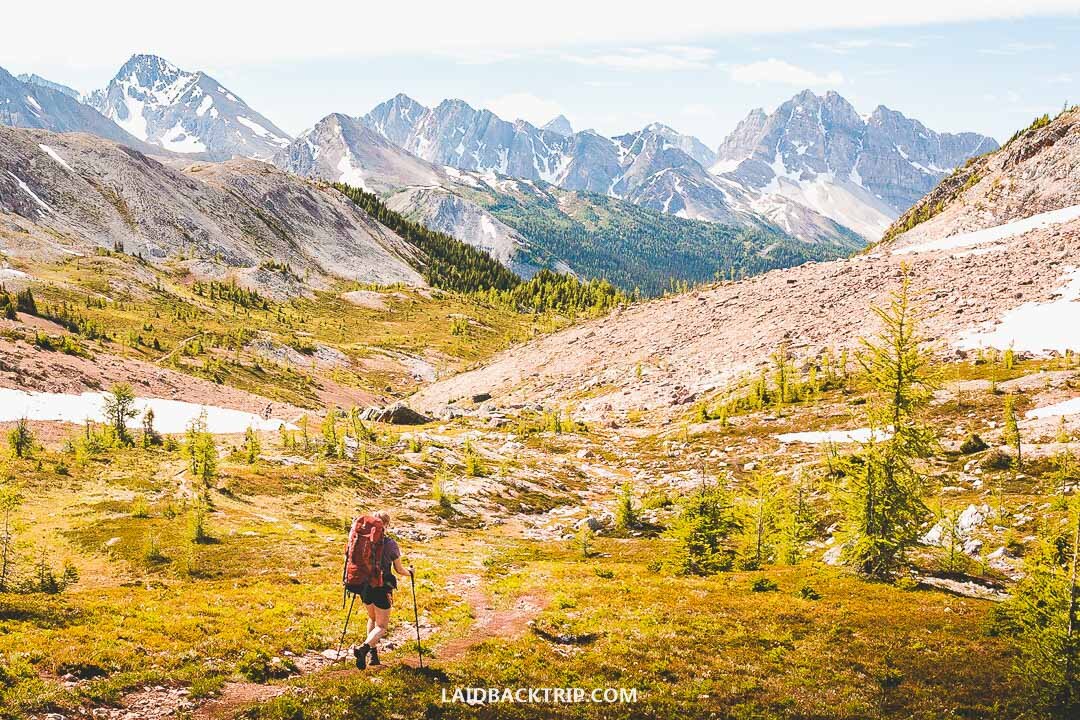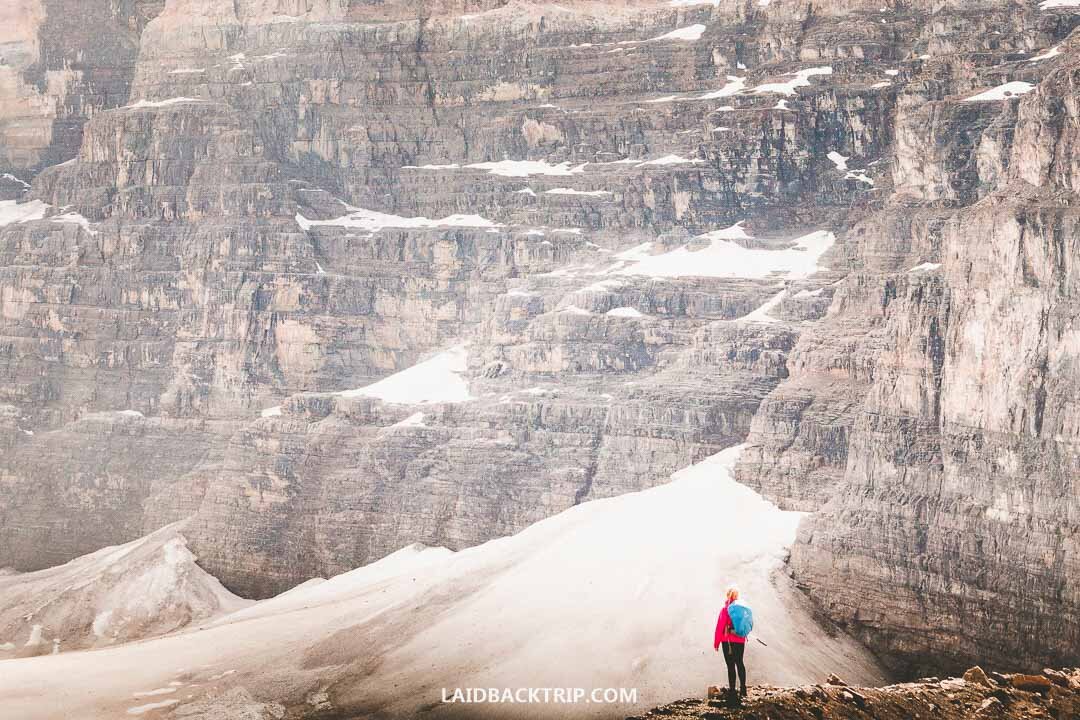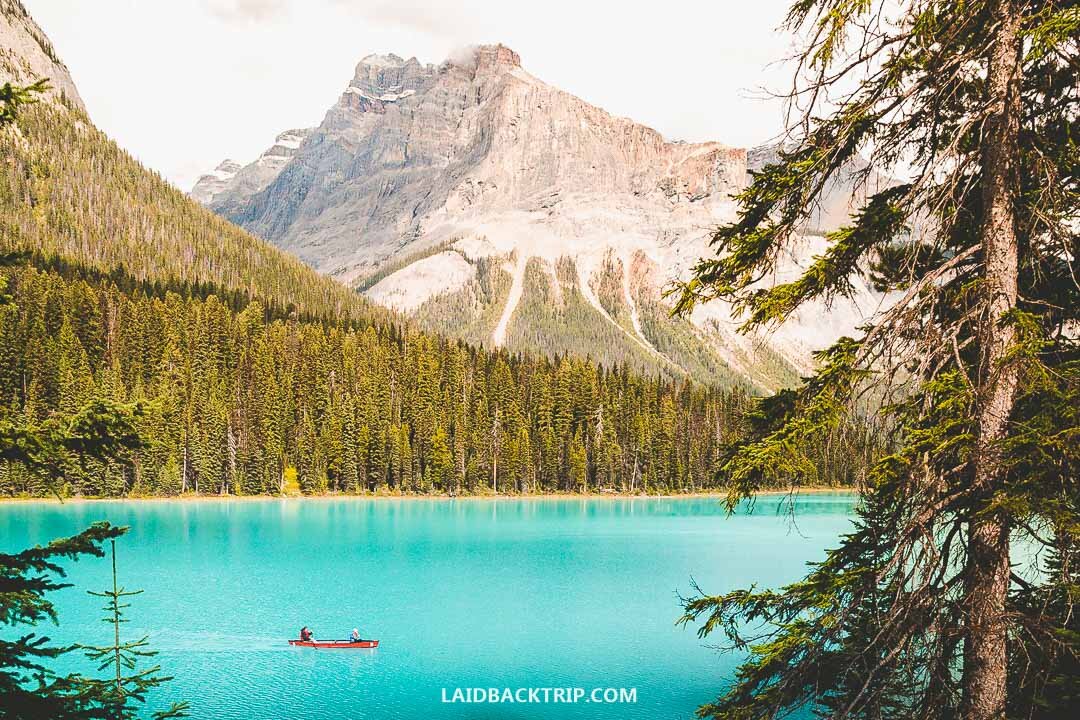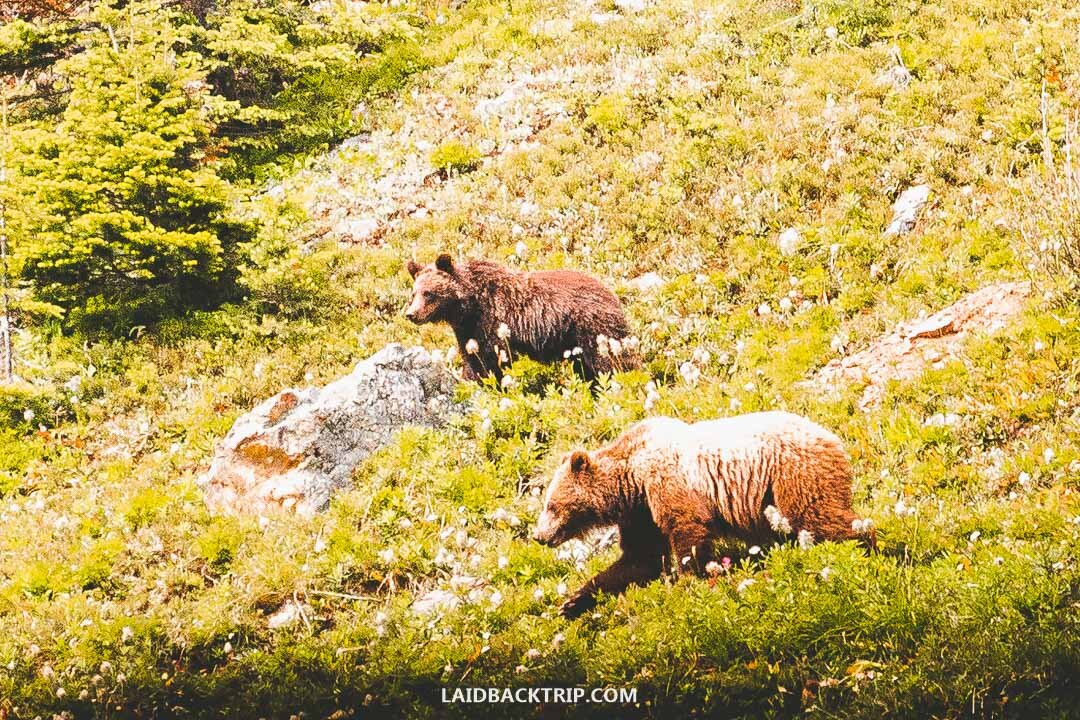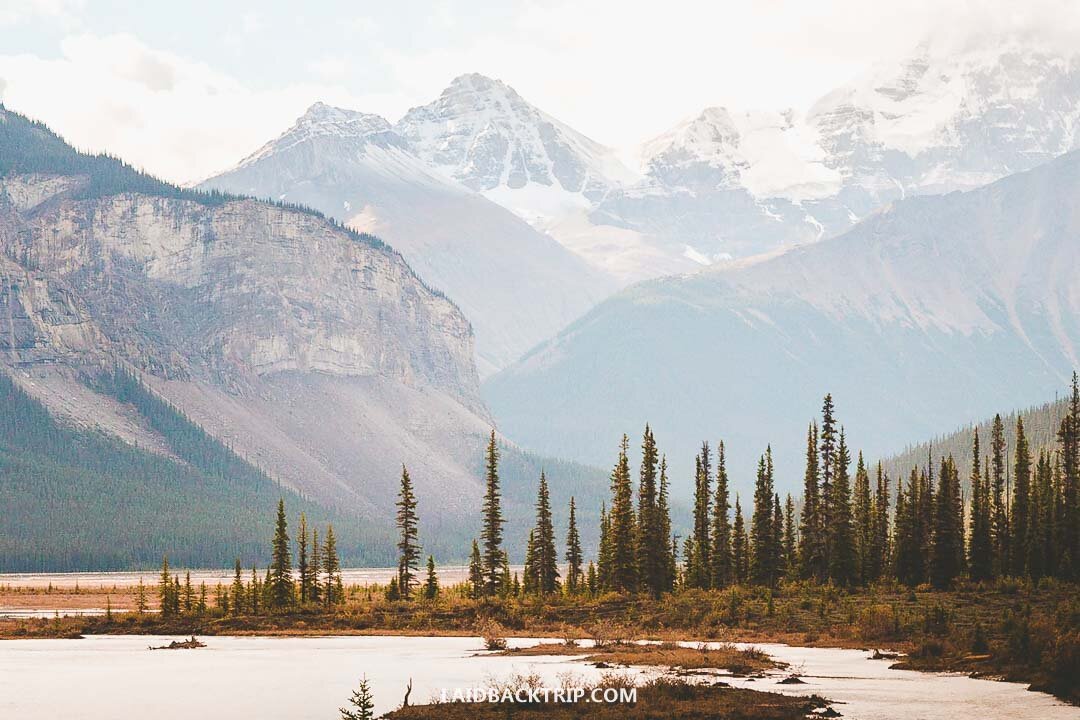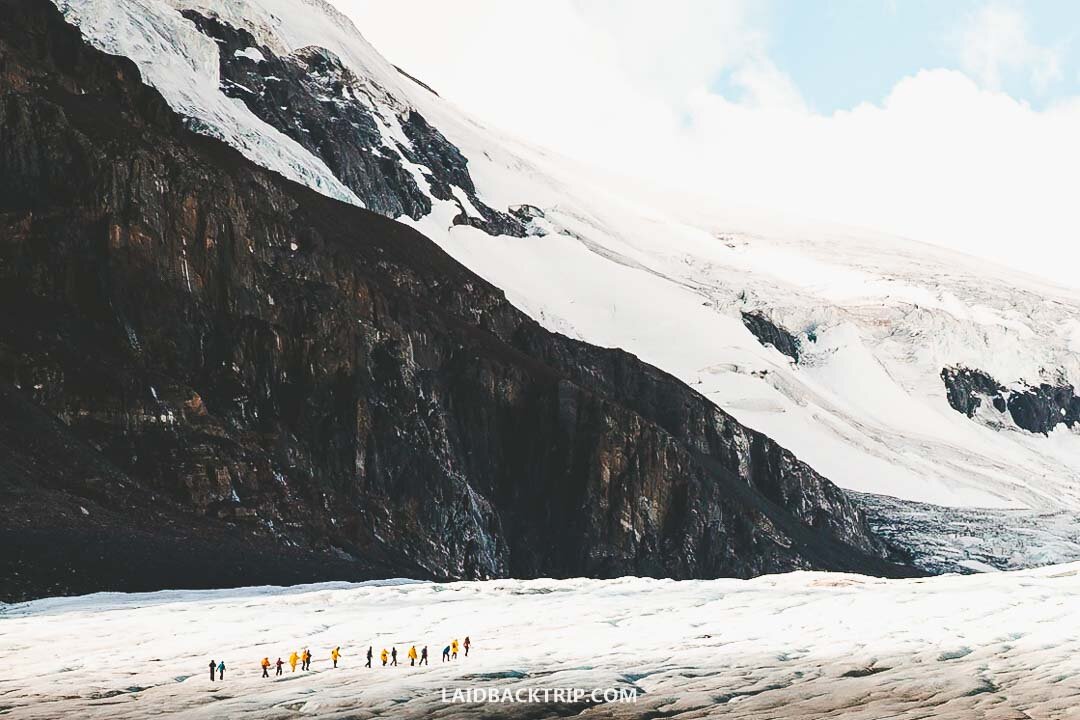The Canadian Rockies Packing List for All Seasons
What should you pack when traveling to the Canadian Rockies and plan on visiting world-known destinations such as Banff, Jasper, or Lake Louise? Here's our tried and tested ultimate Canadian Rockies packing list for summer or winter vacation.
Unpredictable. That's the word that comes to our mind every time someone asks us about the Canadian Rockies' weather.
We lived in Calgary, a city only an hour's drive from the mountains for a year, and when we were already looking forward to summer, a snowstorm came. When we were freezing in the winter, suddenly, out of nowhere, warm winds blew from god knows where and we were sweating in our super-warm coats.
And if the weather was unpredictable in the city, you can be sure it is even more challenging in the mountains. That's why, if you plan a trip to the Canadian Rockies, creating a packing list is one of the first things you should do.
Layers. As it is hard to answer what the weather will be like during your visit when packing for your ultimate trip to the Canadian Rockies, unfortunately, you must pack a bit of everything.
Sure, summers are undoubtedly warmer than winter times, but it can be cold in the mountains any time of the year, and we must admit that we found our down jackets handy, even in July.
Do not worry that you will overpack; we believe you will use everything on the following packing list at least once.
We've decided to create this packing list for every season you can experience in the Canadian Rockies because spring, summer, autumn, and winter tend to blend into one another.
Also, this list can be used by every type of traveler, avid hikers, or road trippers who do not want to leave the comfort of their cars.
No matter if you are an outdoor traveler with a tent on your back, or if you travel from one place to another by rental car and get off the vehicle for a minimum amount of time, or if you plan on spending weeks in the mountains in your campervan, we've got you covered.
Here's our Canadian Rockies packing list that was tried and tested during multiple visits to this fantastic part of the world that will give you answers on what to pack and what to leave behind.
HOW TO GET AROUND THE CANADIAN ROCKIES
The way of transport around the Rockies will not only define how your trip will look like, but it will also help you to solve the problem with packing as well.
The most popular and best way how to travel around the Canadian Rockies is, by far, a rental car - you can rent a standard car and sleep in hotels, or you can opt for traveling in a van and stay overnight in campgrounds.
Renting a car in Canada is very easy, there are plenty of rental agencies in Calgary, Edmonton or even Vancouver.
Do not forget that, especially in the high season, you should make your reservation for both car and accommodation well in advance from June to October.
Not only the road trip in the mountains gives you freedom, but it is also much easier to pack because you can store much more stuff in the car's trunk.
Sure, the car is not inflatable, but it gives you more space than a backpack.
Generally, getting around the Rockies by bus is possible, but not many travelers do it this way because public transport is not regular in this part of Canada, and it can happen you won't be able to get to every destination on your Canadian Rockies itinerary.
Moreover, most of the bus lines run only in the summer plus you would have to pack more minimalistic.
Another option for those without their own transport and plenty of time is hitchhiking, or you can base yourself at one place and take several multiple trips either on your own or with a tour.
WEATHER IN THE CANADIAN ROCKIES
When a traveler planning a trip to the Canadian Rockies asks what's the weather like or what the seasons are, he or she actually wants to know when is the best time to visit the Canadian Rockies.
We must admit it is one of the most complex questions to answer because of the ever-changing conditions, but there are a pattern and four distinctive seasons that define the packing list more or less.
If you plan on visiting the Rockies for skiing, the answer is relatively straightforward - ski resorts should have enough snow between December and April, maybe even in May.
If your main intention why to visit the Rockies is to hike in the mountains and have a smooth road trip around the must-visit attractions near Banff, Lake Louise, Yoho, and Jasper, your best bet is to visit Canada between late spring until mid-autumn.
Temperatures from May to October are milder, snow melts (you can still experience snow causing hiking path and road closures even during summer, so plan a backup itinerary), you can see plenty of wildlife, and overall, this is your best chance to enjoy the Canadian Rockies in its best.
Early summer can be a bit rainy with hails, so be ready for this possibility as well.
You always have to make a compromise between the supposed-to-be-best-season and the number of people you want to share this incredible place with during your travels as this number is exponentially increasing closer to summertime.
We feel that the Canadian Rockies are on top of its visitors' capacity, especially during the summer months, in July and August.
WHAT TO PACK FOR THE CANADIAN ROCKIES
When preparing for a trip, our primary goal is to pack efficiently and as lightly as possible. The key to success, from our point of view, is layers and quality gear.
We prefer functional clothes that we can combine and take on and off depending on the current weather. It is always better to pack your tried and tested gear, especially when it comes to footwear so that you won't be unpleasantly surprised.
When it comes to packing specifically for the Rockies, we would always prefer quality outdoor gear over the look. If there's one thing, every traveler should realize, once you leave the parking lot behind, this destination is all about wilderness, and this should also reflect your packing list.
LUGGAGE
No matter if you will spend most of your time in a car or if you want to explore every hiking trail possible, you need to pack your stuff somehow.
If you want to keep your car's trunk in order makes sense to pack your stuff in a suitcase, but we definitely prefer backpacks when getting around by bus.
Except for the main luggage, you should not forget a smaller daypack for short hikes.
Backpack 45-55L | Backpacks are our favorite gear when traveling, and we prefer them over suitcases, even when they are safely stored in the car. Backpacks are also necessary when you have on your itinerary some multi-day hikes such as Mount Assiniboine or Lake O'Hara. The disadvantage is that it is harder to keep things in order in a Backpack; check out the packing cubes below.
Suitcase | If you know you will be traveling in a car and staying in hotels when traveling in the Rockies, we can recommend you this suitcase.
Daypack | For short one-day hikes, we recommend you to bring along medium-sized daypacks where you can store essential things like water, snack, and extra layers. The backpack should have good back support and a waist strap, so it feels natural and comfortable on your back.
Ultralight Packable Daypack | In case hiking is not your thing, and you will only from time to time get out of the car to admire crystal clear lakes and stunning vistas along the way, we think this light foldable backpack is the right thing for you.
Packing Cubes | Whenever we travel, we always find packing cubes useful. Not only will it keep your luggage organized, but it protects your clothes as well a bit.
Dry Sacks | To keep our valuables and electronics safe, we always pack three or four drybags. It doesn't weigh anything, and it can save you a couple of thousands of dollars.
CLOTHES
The packing list for clothes is inevitably the longest. It's been said a lot about Canada's challenging weather conditions, and although we definitely do not want to scare you off, you should not underestimate it by any means.
This section outlines all clothes we think are essential to pack for the Canadian Rockies for all travelers who plan to spend their time in the mountains actively.
Of course, you can also pack regular clothes for dining in the restaurant, but here's rather a list of things you should not leave behind.
Functional Underwear | Functional underwear is great for every occasion, but especially for those of you who plan on hiking. Pack as many as you like; there is often laundry in hotels or some campgrounds as well.
Thermal Underwear | We don't want to freak you out, but it can get very cold at night. Thermal underwear is an excellent solution for how to feel comfortable. This item is optional, but those who are camping or sleeping in a van should for sure pack this item.
Merino Hiking Socks | High-quality socks reduce impact, help to slide into shoes, prevent blisters and irritation. Although it seems irrelevant, pack extra socks as it is important to start every day in dry socks. Also, we used one pair of warm socks for sleeping.
Merino Warm Socks | After all day hiking, when going to your tent or only when you want to feel cozy in your lodge, warm socks is exactly what you need.
T-shirt | When traveling in the Rockies in the summer, we had many times fine weather when we did not need to wear anything but a short-sleeved t-shirt and shorts.
Long Sleeve T-shirt | We used the long-sleeve t-shirts to prevent sunburnt or when it was colder as an additional layer. Take an extra long-sleeved t-shirt for sleeping or cold afternoons in a campground.
Fleece Jacket | It is essential to pack at least one fleece jacket to stay warm when you stop hiking and take a break for a while. A fleece jacket is also practical when driving along Icefields Parkway, and you stop every five minutes to go out from the car to take a millionth picture.
Down Jacket | A down jacket will help you keep warm during the cold evenings in the camp or early in the morning when you arrive at the shore of Lake Louise or toe of the Athabasca Glacier to admire the incredible scenery. I think we did not see a single traveler without a good-quality jacket in the Rockies as it also looks good on pics.
Windbreaker | It can be very windy, and the wind is chilly higher you climb. A windbreaker is light and keeps you warm.
Rain Jacket | One of the most essential gear for outdoor adventures is a waterproof jacket. It protects you from rain and snow showers as the weather in the mountains is unpredictable.
Jeans | Wearing comfortable jeans or any other comfortable pants is an excellent option if you want to look casual. Some people prefer wearing jeans for short walks, we only do not recommend them for hiking.
Rain Pants | It might rain and snow anytime, so it’s better to come well-prepared. Rain trousers are baggy, but the main feature is that you can put them on quickly and easily.
Hiking Pants | Hiking pants should be comfortable, breathable, and durable because you will spend most of your time wearing them. I usually prefer wearing leggings no matter where we travel but found hiking pants handy here because of cold and strong winds.
Leggings | Pack at least one pair of leggings with you. We use them as an additional layer under hiking pants or instead of pajama trousers.
Shorts | It can be quite warm in the Rockies when the sun shines, so bring along comfortable shorts.
Multifunctional Headwear | Multifunctional headwear is a great little thing that won't take any space in your backpack, and you can use it as sun protection, or against wind or dust. You can also use it as a headscarf, neck warmer, or face warmer. This little item is an essential thing for traveling we never leave home without.
Gloves | Great for low morning temperatures and when holding trekking poles.
Beanie | Mornings and evenings are chilly in the mountains all year round, so bring beanie to keep yourself warm.
Winter Gloves | We recommend you bring winter gloves in case of a snowstorm and extremely cold weather, especially when you travel in the Canadian Rockies between November and March.
FOOTWEAR
Footwear should correspond with the season when you plan on traveling to the Rockies and activities you have on your itinerary.
But generally, you should have one pair of light shoes for dry conditions and walking around towns, one pair of hiking waterproof boots you can use for trekking or when it rains, and one pair of shoes for warmer weather and to give your feet relief
Runners | Many top places in the Rockies are easily accessible, and you often do not need to wear heavy hiking boots. That especially applies to walking around touristy towns such as Banff, Jasper, or Lake Louise.
Hiking Boots | We said that before and will repeat it. Buy quality and waterproof hiking boots, make sure they fit and feel comfortable before your trip to the mountains. Even if you do not plan to hike many kilometers a day, we think hiking boots must-have.
Flip-flops | After trekking, you can change to flip-flops in your room or when you go to shower.
GEAR
Packing gear is always our least favorite activity as it usually adds extra weight, but we often find it useful when we expect it the least.
Some items on this list are very specific for this country, such as bear spray, while most of them are pretty common, and we believe you pack them on almost every international trip.
Trekking Poles | Years ago, Nepal was the first country where we used hiking poles, and as we had a great experience, we always pack them from that time. Hiking poles will help your knees when hiking downhill or uphill and are great for establishing walking pace and rhythm.
Bear Spray | You are in a Bear Country; make sure you carry a bear spray. You can buy it in outdoor shops around Canadian Rockies, but the price is always higher, so it is better to stock this item in advance.
Rain Poncho | Rain poncho is great when the rain is too heavy; you can also use it as an emergency shelter. We even prefer a plastic rain poncho over a waterproof jacket when it rains a lot because we can cover backpacks as well.
Sunglasses | You need to keep your eyes protected at all times because the sun in the mountains is strong. Wear sunglasses also in the winter because snow reflects the sun.
First Aid Kit | First Aid Kit is a must-have, pack all medications you use on a daily basis, plus pills against diarrhea and headache.
Duct Tape | When your backpack or boots break down, it can be hard to find a replacement when you need it the most. Duct tape might do the magic.
Travel Insurance
We never leave home without travel insurance that was designed to cover our expenses if something goes wrong during the trip.
Travel insurance protects against theft, flight delays, injury, illness, cancellations, and much more.
World Nomads provides travel insurance for travelers to cover their trip essentials, including sports and adventure activities.
SafetyWing is affordable travel insurance for backpackers, long-term travelers, and digital nomads.
Travel smarter and safer!
WATER
Staying hydrated is very important, especially in this destination, where you can easily spend many hours per day outdoors. Tap water in Canada is drinkable, and it is sometimes even possible to refill your water bottle in the mountains from a stream.
As we aim to travel as responsibly as possible, the first step on this journey is to lower our plastic consumption.
Here are the most common alternatives if you want to avoid single-use plastic bottles.
Water Bottle | We believe that a classic reusable water bottle should be nowadays on every traveler's eco-friendly packing list. Although Canada is not the most budget-friendly country, water is one of the things you can save on; it is enough to refill the bottle before any trip at a campground or in your hotel room. We were also able to fill our water bottle on hikes such as Aylmer Lookout, Bourgeau Lake, or Plain of Six Glaciers.
SteriPen | If you're looking for an alternative to treating water (if you're on a multi-day trip without access to drinking water), there are nowadays ways that can easily do the job for you. SteriPen is a useful gadget that kills bacteria almost straightaway.
Water Bottle With a Filter | If you're looking into ways how to stay hydrated on the road without being dependant on buying water in grocery stores, yet you do not entirely trust public sources, check out this bottle that already has an integrated filter.
CAMPING
Sleeping at campgrounds is a popular way to enjoy the mountains, and it is also a way to reconnect with nature. We were grateful we were able to combine road tripping with several tramping trips; therefore, we had to think about what to pack.
Always consider whether it is possible to rent the gear on the spot as camping stuff is heavy. When you plan on camping in the Canadian Rockies, consider packing the following items.
Lightweight Tent | Weather conditions in Canada can be harsh, so make sure to pack a windproof and waterproof tent. Pack a light tent in case you will be hiking multi-day treks.
Sleeping Bag | For camping or sleeping in a van or motorhome, pack a warm sleeping bag. We prefer down sleeping bags. They are often more expensive, but you can feel the difference.
Mummy Liner | We never travel anywhere without cocoon because we use it as an additional layer for a sleeping bag or as a protection when we stay overnight in a shabby hostel.
Sleeping Mat | The cold at night usually comes from the ground - the air mattress should protect you the best, plus it is small and light.
Cooking Set | To save money, consider cooking your own meals instead of going to restaurants every day. Cooking sets often come with rental campervans - find out this information in advance.
Cooking Stove | Pack only a stove. You can find gas cans even in small, not specialized stores.
Stove Screen | When there is no shelter around, cooking is more comfortable with the stove screen as it protects the fire from blowing wind.
Headlamp | You do not need a headlamp when staying in hotels and lodges, but you will appreciate it in campgrounds for sure.
Travel Towel | Light and fast-drying towel is another must-have thing no matter where you go.
Dried Food | For hiking, we tried dehydrated food for the first time here in Canada and really liked it. It is a bit more expensive, but it is light, and the food is cooked ready quickly.
Foldable Knife | A sharp knife is essential thing to have for camping in the wilderness.
TOILETRIES
When packing toiletries, always think twice about what you really need.
We found it quite useful lately when traveling only for two or three weeks to purchase small travel bottles to save space.
Sunscreen | We used SPF 50+ every day on every part of our bodies exposed to the sun as it can be extremely strong even when it is cloudy.
Lip Balm | A common mistake when hiking is to use only sunscreen but forget to protect your lips. Lip balm also helps to protect your lips against the wind.
Bug Repellent | Some places can be infested by mosquitoes in the summer; therefore an organic bug repellent is a must-have.
Natural Toothpaste | Bamboo Toothbrush | Shampoo | Soap | Toilet Paper | Wet Wipes | Hand Sanitizer | Manicure Kit | Travel Comb
Glasses | Contact Lenses | Contact Lens Solution
ELECTRONICS
Electronics are an integral part of our lives, so you should pack everything you find necessary. Try not to overpack, but we are fully aware that things like phones or chargers no one leaves at home.
Of course, do not leave your electronics unattended in the car, or at least leave it out of sight. This is what we brought with us.
iPhone | We are big fans of Apple products because they simply work. Whether you use your mobile phone as a map, alarm clock, watch, flashlight, or the main photo camera, it's hard to imagine traveling without it these days.
Phone Case | When you use your phone as a camera, take a phone cover because you will take it out of your pocket too often.
iPad | iPad or small laptop is great to have with you so you can watch movies later at night or transfer photos from your camera.
Kindle | For us, having a portable library is a luxury we don't want to give up when traveling.
Chargers | Do not forget cables and chargers to keep your electronics working. Always check out whether the outlets are the same; you will likely need a travel adapter.
Travel Adapter | We solved the problem of different electrical plugs and sockets by buying a multi-plug adapter, so we don't have to think about charging our stuff no matter where we go.
Power Bank | In case you won't be able to charge your stuff in a hostel, bring a power bank or solar power bank.
Apple Watch | Smartwatch has been very trendy lately, and you can find it useful for outdoor activities such as hiking, biking, or running.
PHOTO GEAR
It might be because of the very nature of our job, but we cannot imagine traveling without our trusty travel camera.
The Canadian Rockies is one of the most photogenic destinations we've ever visited, and we love going through photos we've taken, so we can only recommend you invest in a camera that fits your travel style and budget.
Canon EOS R6 | Modern cameras are capable of so much, and this camera is one of the best on the market. It has an excellent dynamic range, superb autofocus, and it's easy to use.
Canon RF 24-70mm F2.8 | If you bring a camera, you need a general-purpose zoom lens, so you don't have to change it all the time.
Canon RF 100-500mm F4.5-7.1 | Staying safe while taking photos of wildlife is essential. This telephoto lens has a wide range of focal lengths, making it an excellent fit for wildlife photographers.
Tripod | To get even better sunrise, sunset, or night photos, pack a small portable tripod.
Canon Battery LP-E6N | We always carry a few extra batteries, just in case.
Memory Card | When not carrying a backup solution, like a laptop, bring extra memory cards. Trust us nature around is so beautiful that you will need them.
Photo Cleaning Kit | It can rain or snow any time. So take care of your equipment and keep it clean and dry.
WHERE TO STAY IN THE CANADIAN ROCKIES
There's a wide range of accommodation options in the Canadian Rockies. Still, during times of peak demand (especially July to October and then winter months in ski resorts), you must book your room well in advance.
Towns where it is the most difficult to find accommodation are Lake Louise, Banff, and Jasper, but be ready prices during the high season are skyrocketing.
For those traveling on a budget, the cheapest option is to stay in campgrounds (in a tent, car, or RV). There is no shortage of campgrounds in the Canadian Rockies.
Still, they also tend to fill quickly when the booking window opens, and nowadays, we would not travel to the Canadian Rockies without reservation.
Calgary | Wingate by Wyndham Calgary Airport - Are you tired after a long flight and don't want to drive? Stay at Wingate hotel close to the airport. You can rent your car the next day, which will save you money.
Banff | Banff Park Lodge - An environmentally friendly hotel located in the town center surrounded by stunning scenery is one of Banff's top choices, which is one of the most sought-after destinations in the Rockies.
Lake Louise | Fairmont Chateau Lake Louise - One of the most controversial hotels in the Rockies stands on the shore of beautiful Lake Louise. It is also one of the most luxurious properties, so if you can afford it, go for it.
Jasper | Jasper Inn and Suites - Are you looking for a hotel with an excellent location, cozy rooms, sauna, and steam room? Right in the center of Jasper is located this hotel, which offers exactly that.
Golden | Best Western Mountainview Inn - Soak in the Golden's history tied to the Canadian Pacific Railway and the logging industry. Golden is often considered an off-the-beaten-path destination, but it has a lot to offer, and the hotel's selection is quite wide.
Travel Resources
Here you can find links to all the travel resources we use and which you might find helpful when planning your next holiday.
Accommodation: When looking for accommodation, we usually search hotels via Booking.com or Hostelworld.
Tours: Although we love to travel independently, some places are better to visit with a guided tour.
We prefer GetYourGuide for its easy-to-use interface and solid reputation. Another great alternative is Viator.
Rental Cars: When going on a road trip, we always use Rentalcars.com, a reliable site for booking a rental car in advance.
Flight Tickets: When looking for flight tickets, you can search Skyscanner to find the best price.
Travel Insurance: World Nomads and SafetyWing cover against risks of travel.
Some of the links on this post are affiliate links. If you choose to purchase using these links, we receive a small commission at no extra cost to you.
